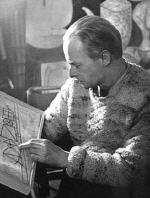
Paul Klee was born on December 18, 1879, in Munchenbuchsee, Switzerland, into a family of musicians. His childhood love of music was always to remain profoundly important in his life and work. From 1898 to 1901, Klee studied in Munich. Upon completing his schooling, he traveled to Italy in the first in a series of trips abroad that nourished his visual sensibilities. He settled in Bern in 1902. A series of his satirical etchings was exhibited at the Munich Secession in 1906. That same year, Klee married Lily Stumpf, a pianist, and moved to Munich. Here he gained exposure to Modern art.
Klee met Alexej Jawlensky, Vasily Kandinsky, August Macke, Franz Marc, and other avant-garde figures in 1911; he participated in important shows of advanced art in Munich and Berlin. In 1912, he visited Paris for the second time, where he saw the work of Georges Braque and Pablo Picasso and met Robert Delaunay. Klee helped found the Neue Munchner Secession in 1914. Color became central to his art only after a revelatory trip to Tunisia in 1914.
In 1920, a major Klee retrospective was held in Munich. Klee taught at the Bauhaus in Weimar from 1921 to 1926 and in Dessau from 1926 to 1931. During his tenure, he was in close contact with other Bauhaus masters, such as Kandinsky and Lyonel Feininger. In 1924, the Blaue Vier, consisting of Lyonel Feininger, Jawlensky, Kandinsky, and Klee, was founded. Among his notable exhibitions of this period were his first in the United States in 1924; his first major show in Paris the following year and an exhibition at the Museum of Modern Art, New York, in 1930. Klee went to Dusseldorf to teach at the Akademie in 1931, shortly before the Nazis closed the Bauhaus. Forced by the Nazis to leave his position in Dusseldorf in 1933, Klee settled in Bern the following year. Klee died on June 29, 1940, in Muralto-Locarno, Switzerland.